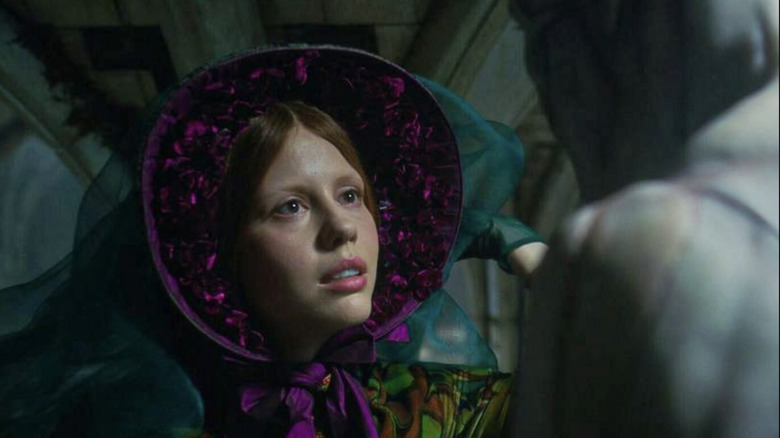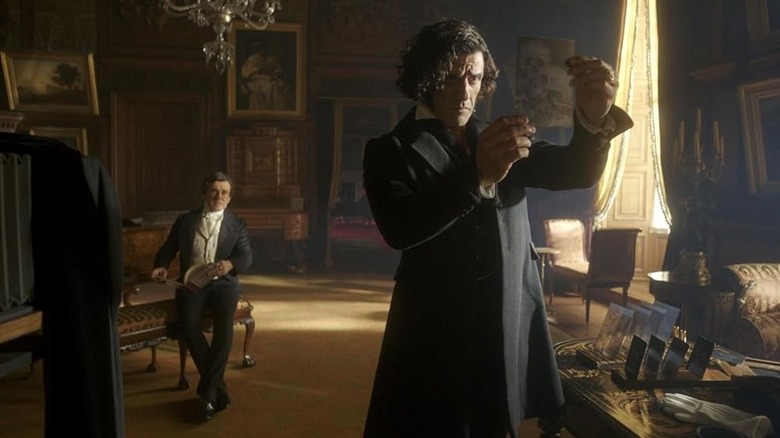Guillermo Del Toro's Frankenstein Quietly Remakes One Of The Greatest Horror Sequels Ever
This article contains spoilers for "Frankenstein."
Even the most genre illiterate person is aware that numerous cinematic adaptations of Mary Shelley's 1818 novel "Frankenstein" exist, which is why every new iteration of the classic story feels beholden to those that have come before. That said, there's no denying the cultural influence of James Whale's two films for Universal PIctures in the 1930s, 1931's "Frankenstein" and 1935's "Bride of Frankenstein," which established such strong visual iconography for the story that a large number of subsequent adaptations of Shelley have paid homage to them in one way or another. Even those adaptations which have sought to steer away from Whale's work find it hard to escape. Yet concurrent with this influence is an implicit understanding that Whale's films should not be remade outright, thus every other "Frankenstein" film has also sought to establish its own identity, even (almost especially) when the original Shelley novel is being retold.
Filmmaker Guillermo del Toro remains true to this unspoken tradition with his version of Shelley as seen in 2025's "Frankenstein." Yet while the film is unmistakably del Toro's and bears little to no resemblance to Whale's movies, the director does pepper in many elements which recall prior "Frankenstein" films, essentially acknowledging the story's long, proud history on-screen. In addition to allusions to the Hammer "Frankenstein" series, Kenneth Branagh's "Mary Shelley's Frankenstein" and others, del Toro includes several aspects within his "Frankenstein" which recall Whale's "Bride of Frankenstein." When taken together, these aspects make the film feel almost like a quiet remake of the 1935 classic, which is one of the greatest horror sequels ever made. Even more delightful is the way del Toro remixes and subverts these elements, making them feel completely like a part of his film even as they homage.
Del Toro's Frankenstein features a Dr. Pretorius analogue and a kindly blind man, as in Whale's film
While Whale's 1931 "Frankenstein" took a number of liberties with Shelley's text but generally stayed true to the story, "Bride of Frankenstein" saw the director taking the source material and running with it. Several new characters and situations were conceived for the film, amongst them the Bride herself (who gets made in Shelley's novel, but is destroyed before she can be brought to life) and Dr. Pretorius (Ernest Thesiger), Henry Frankenstein's (Colin Clive) mentor who encourages him to continue his work out of amoral egomania.
In del Toro's "Frankenstein," the character of Henrich Harlander (Christoph Waltz) can be seen as a Pretorius analogue. Although Harlander is not quite as egomaniacal as Pretorius, he has highly selfish reasons for spurring on Victor Frankenstein (Oscar Isaac), as he hopes that the scientist's research may save him from dying of syphilis. This dilemma is made even more unsavory when Harlander offers his daughter, Elizabeth (Mia Goth) to Frankenstein as incentive, despite the fact that she's already betrothed to Victor's brother, William (Felix Kammerer). Harlander's accidental death during the Creature's creation also feels akin to Pretorius perishing in the collapse of the castle at the end of "Bride."
Another allusion to "Bride" lies within the section of del Toro's film where the Creature (Jacob Elordi) comes upon a family's remote farmhouse to take shelter in. This leads to him befriending the elderly blind grandfather (David Bradley) after everyone leaves the man alone for the winter. Although this plotline comes directly from Shelley's novel, it also recalls the moment from "Bride" where the Monster (Boris Karloff) befriends a blind hermit (O.P. Heggie). In both films, the newfound friendship is cruelly cut short, increasing the Creature's loneliness.
Mia Goth's Elizabeth is a very Bride-like character
Despite some visual allusions, it's the characterizations in del Toro's film which makes "Frankenstein" feel close to a reimagining of "Bride of Frankenstein." In Whale's films, Henry Frankenstein is presented more as an antihero then the indecisive character in Shelley's novel. Thus, his experiments are positioned more as the folly of someone well-intentioned but deeply misguided. By the end of "Bride," the Monster decides that he, the Bride, and Pretorius are too different to assimilate into society and thus they "belong dead," and Frankenstein is left with multiple layers of guilt and shame at his responsibility for this.
In del Toro's "Frankenstein," Victor is portrayed as more villainous, a man wounded from his toxic and abusive relationship with his father, Leopold (Charles Dance), who finds himself revisiting that abuse on his son, the Creature. He also misses the love he shared with his mother, Claire (also Goth, in a psychosexual twist on del Toro's part), and though he and Elizabeth seem to have some attraction to each other, the woman finds him too toxic to give into. She's not all that passionate about her fiancé William, either. Instead, her true love appears to be the Creature, as the two discover a kinship right from the moment they meet. Not only is this very del Toro (who made the monster lover film "The Shape of Water"), it's also a clever subversion of both Shelley and Whale. In contrast to Shelley, this Elizabeth does not die at the Creature's vengeful hand, but rather in an attempt to protect him. In parallel to Whale, the relationship between the Bride and the Creature is tragically not to be. These subversions, allusions, and homages help make del Toro's "Frankenstein" the richly layered film that it is.


